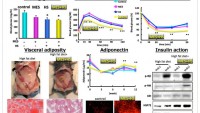Chemists Discover Structure of Bacterial Enzyme that Produces Biodegradable Plastics
| Arthur Dominic Villasanta | | Nov 15, 2016 11:34 PM EST |
(Photo : MIT News) MIT chemists have determined the structure of a bacterial enzyme that can produce biodegradable plastics.
MIT chemists have taken a huge step toward producing better biodegradable plastics by determining the structure of a bacterial enzyme that can produce this kind of plastic.
This advance will help chemical engineers improve the enzyme to make it even more industrially useful.
Like Us on Facebook
The enzyme called "polyhydroxyalkanoate (PHA) synthase" generates long polymer chains that can form either hard or soft plastics, depending on the starting materials that go into them.
Learning more about the enzyme's structure could help engineers control the polymers' composition and size. This will be a step toward commercial production of these plastics, which should be biodegradable unlike conventional plastic formed from petroleum products.
"I'm hoping that this structure will help people in thinking about a way that we can use this knowledge from nature to do something better for our planet," said Catherine Drennan, an MIT professor of chemistry and biology and Howard Hughes Medical Institute Investigator.
"I believe you want to have a good fundamental understanding of enzymes like this before you start engineering them."
Drennan and JoAnne Stubbe, the Novartis Professor of Chemistry Emeritus and a professor emeritus of biology, are the senior authors of the study, which appears in the Journal of Biological Chemistry. The paper's lead author is graduate student Elizabeth Wittenborn.
Polyhydroxyalkanoate (PHA) synthase is found in nearly all bacteria, which uses it to produce large polymers that store carbon when food is scarce. The bacterium Cupriavidus necator can store up to 85 percent of its dry weight as these polymers.
The enzyme produces different types of polymers depending on the starting material, usually one or more of the numerous variants of a molecule called hydroxyalkyl-coenzyme A, where the term alkyl refers to a variable chemical group that helps determine the polymers' properties.
Some of these materials form hard plastics, while others are softer and more flexible or have elastic properties that are more similar to rubber.
PHA synthase holds great interest for chemists and chemical engineers because it can string together up to 30,000 subunits, or monomers, in a precisely controlled way.
"What nature can do in this case and many others is make huge polymers, bigger than what humans can make," said Stubbe. "And they have uniform molecular weight, which makes the properties of these polymers distinct."
Drennan, Stubbe, and other chemists have been pursuing this enzyme's structure for many years, but until now it has proven stubbornly elusive because of the difficulty in crystallizing the protein. Crystallization is a necessary step to performing X-ray crystallography, which reveals the atomic and molecular structure of the protein.
Two former graduate students, Marco Jost and Yifeng Wei, who are also co-authors on the paper, worked on the crystallization as a side project and succeeded just before leaving MIT.
Once the researchers had the crystals, Wittenborn collected and analyzed the resulting crystallographic data to come up with the structure. The analysis revealed that PHA synthase consists of two identical subunits that form what is known as a "dimer."
Each subunit has an active site in which the polymerization occurs, thus eliminating an earlier proposal that the active site would be located at the dimer interface.
The analysis also revealed the enzyme has two openings -- one where the starting materials enter and another that allows the growing polymer chain to exit.
Drennan's lab now plans to try to solve structures of the enzyme while it is bound to substrates and products, which should yield even more information critical to understanding how it works.
"This is the beginning of a new era of studying these systems where we now have this framework, and with every experiment we do, we're going to be learning more," said Drennan about their biodegradable plastics discovery.
TagsMIT, biodegradable plastics, polyhydroxyalkanoate (PHA) synthase, Enzyme, Catherine Drennan
©2015 Chinatopix All rights reserved. Do not reproduce without permission
 NASA, FEMA Simulate Asteroid Strike on Los Angeles; Agree on the Best Option for Survival
NASA, FEMA Simulate Asteroid Strike on Los Angeles; Agree on the Best Option for Survival Wars on Drugs have been Failures and will Continue to Fail; New Methods are Needed
Wars on Drugs have been Failures and will Continue to Fail; New Methods are Needed Robotics Roadmap Shows Way Forward for US in the Trump Years
Robotics Roadmap Shows Way Forward for US in the Trump Years Wearable Medical Device for Type 2 Diabetes Effective vs Visceral Fat
Wearable Medical Device for Type 2 Diabetes Effective vs Visceral Fat
EDITOR'S PICKS
-

Did the Trump administration just announce plans for a trade war with ‘hostile’ China and Russia?
-

US Senate passes Taiwan travel bill slammed by China
-

As Yan Sihong’s family grieves, here are other Chinese students who went missing abroad. Some have never been found
-

Beijing blasts Western critics who ‘smear China’ with the term sharp power
-

China Envoy Seeks to Defuse Tensions With U.S. as a Trade War Brews
-

Singapore's Deputy PM Provides Bitcoin Vote of Confidence Amid China's Blanket Bans
-

China warns investors over risks in overseas virtual currency trading
-

Chinese government most trustworthy: survey
-

Kashima Antlers On Course For Back-To-Back Titles
MOST POPULAR
LATEST NEWS
Zhou Yongkang: China's Former Security Chief Sentenced to Life in Prison

China's former Chief of the Ministry of Public Security, Zhou Yongkang, has been given a life sentence after he was found guilty of abusing his office, bribery and deliberately ... Full Article
TRENDING STORY

China Pork Prices Expected to Stabilize As The Supplies Recover

Elephone P9000 Smartphone is now on Sale on Amazon India

There's a Big Chance Cliffhangers Won't Still Be Resolved When Grey's Anatomy Season 13 Returns

Supreme Court Ruled on Samsung vs Apple Dispute for Patent Infringement

Microsoft Surface Pro 5 Rumors and Release Date: What is the Latest?










